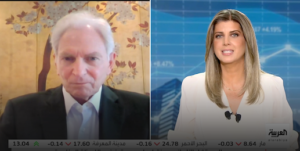The article titled “China’s Belt & Road: new avenues for Middle East growth and economic diversification”, appeared in The National on 12th April, 2018 and is posted below. Click here to access the original article.
China, in 2016, released a strategy blueprint for building its economic and financial relations with the Middle East, titled “China’s Arab Policy Paper”.
But to forging the links between the two geographies is nothing new: a long history since 200 BCE is witness to the strong ties and engagement of the Middle East with China along the old Silk Road trading routes.
The Chinese blueprint proposes the establishment of a “1+2+3” cooperation framework. One is to build on energy cooperation as the core while infrastructure construction and trade and investment facilitation are the two wings of the policy. Three is the breakthroughs in high and new tech fields of nuclear energy, space satellite and new energy that China intends to achieve in the Middle East.
China’s “Belt and Road” (B&R) initiative is an embodiment of this vision: it is China’s modern strategy of revitalising the Silk Road with investments in infrastructure, roads, high-speed rail, ports and airports, to transform economic geography from China to Europe, encompassing parts of the Middle East.
China has created an imposing array of international financial institutions –the Asian Infrastructure Investment Bank (AIIB) along with the China Development Bank, the China Export-Import Bank and others – to fund its ambitions. The countries and businesses on the New Silk Road are bracing for the B&R to shift growth and economic diversification to a new phase.
How can the Middle East and GCC countries benefit and participate in the B&R?
New Avenues for banking cooperation
Since 2014, the Arab countries have signed more than $50 billion in contracts with China. More recently, China has listed Egypt as one of the top five destinations for mergers and acquisitions activity under the B&R initiative.
The UAE , specifically Abu Dhabi Ports, in its capacity as a regional trading hub, has signed a partnership with Cosco, China’s largest shipping company, to build new terminals to support the expected increased flow of trade along the B&R maritime routes.
Approximately 60 per cent of China-UAE trade is re-exported to Africa or Europe, which will support B&R’s purpose, while making the country — and particularly Dubai — an important component of China’s trade strategy in the Middle East, Africa and beyond.
The strong presence of Chinese banks in the GCC provides the financial underpinning for deeper and wider linkages. Banks in the GCC should use their financial muscle make use of this opportunity to provide co-financing with Chinese banks for trade, investment and economic activity in the B&R countries.
This would open wide opportunities for GCC infrastructure, logistics, services and real estate development companies that are internationally competitive.
The GCC banking sector has to expand and pivot East over the coming decades accompanying the shift of economic geography. The shift should be supported by cooperation between central banks, banking and financial sector regulators and supervisors. We should develop Shanghai I regulatory framework rather than a Basel IV.
Use the B&R to drive economic diversification
As the B&R takes shape, the GCC countries can partner with China to drive greater economic diversification through privatisation and public-private partnerships and the transfer of technology.
Energy has obviously been a key element of the relationship: among China’s 10 largest sources of crude oil imports, four of them are the GCC countries. China’s project finance in the Middle East has mostly been in energy and natural resources, similar to investments in other B&R countries.
However, there is a massive opportunity, as many countries along the B&R need to improve their infrastructure stock. This an opportunity for Chinese and GCC sovereign wealth funds to partner, co-invest and co-finance, as well as develop public-private partnerships co-financing of B&R development and infrastructure projects, thereby bringing the Middle East closer to China.
More important is to build for the future.
The GCC countries should build on China’s growing leadership in renewable energy — solar notably, artificial intelligence and blockchain; augmented and virtual reality; Fintech, technologies to combat climate change, robotics and autonomous vehicles; and life sciences to diversify their economies and participate in the emerging Fourth Industrial Revolution.
A GCC-China free trade and investment agreement spanning these areas would build a new platform of cooperation between the two. The New Silk Road is a Digital Silk Road, it is a Tech Silk Road.
Develop and use the PetroYuan
The B&R will also boost the internationalisation of the RMB by encouraging the currency’s use in both trade and financial transactions. Chinese and GCC banks –supported by central bank currency swap arrangements- can efficiently finance China-GCC trade, including oil (GCC, Iran, and Iraq now account for 60 per cent of China’s imported oil, with China now the second largest oil export market for these countries).
It is in the strategic interest of the GCC to be part of the growing Yuan zone. Both the UAE and Qatar already have existing bilateral currency swap agreements with the People’s Bank of China. The GCC payments system should be expanded to include clearing and settlement of RMB. The strategy should be for the “PetroYuan” to be used to finance China’s Middle East oil & gas trade: establish traded Yuan oil spot contracts, an innovation that would strongly reinforce the growing internationalisation of the Renminbi.
The opportunities are only limited by imagination, entrepreneurship and innovation. The GCC countries need to develop a China strategy and policy, completing China’s Arab Policy and ensure it is based on the principles of mutual benefit and win-win results for all participants.
Time to setup an Arab Bank for Reconstruction and Development
Looking beyond the B&R initiative, the AIIB, the EIB, EBRD & other multi-lateral financial institutions, working with GCC sovereign wealth and economic development funds can participate in the finance of the reconstruction and development of war-torn Middle East nations-Iraq, Syria, Libya, Yemen, and Sudan – which have massive reconstruction needs in excess of one trillion dollars.
A Middle East reconstruction and development plan embodied in an Arab Bank for Reconstruction and Development, closely integrating the private sector would be a growth lifting initiative, facilitate the transfer of knowledge and technology, be a major source of job creation to fight Arab youth unemployment, alienation and extremism, alleviate poverty, and start addressing the dramatic and overarching political-social and economic issue of the more than 15 million refugees and forcibly displaced people in our region.





